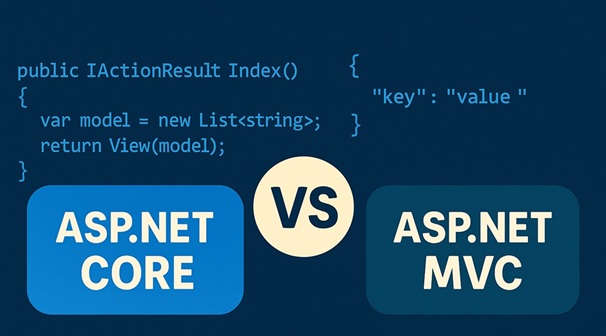The Legacy Trap: Why Monolithic .NET Applications Hold You Back
Traditional .NET monoliths — especially those built on ASP.NET MVC or Web Forms — were ideal for quick development cycles a decade ago. But today, they’ve become the primary bottleneck to agility, scalability, and cloud readiness. Every feature release feels risky. Deployment times balloon. And scaling just one piece of your system? Practically impossible. As business logic becomes entangled and technical debt mounts, monolithic systems put a ceiling on your growth.
Modern Demands Require Modern Architectures
Enterprise software in 2025 needs to be fast, modular, and resilient. Whether you're building logistics platforms, financial services portals, or real-time analytics engines, the expectations have changed. Cloud-native capabilities, CI/CD pipelines, container orchestration, and horizontal scaling aren't “nice-to-have” — they're essential. Microservices architecture, powered by .NET 8 and deployed on Kubernetes or Azure, offers a path toward meeting those demands while reducing operational risk.
But Migrating to Microservices Isn’t Just a Code Refactor
A successful migration requires more than breaking code into smaller pieces. It’s about rethinking domain boundaries, data ownership, deployment pipelines, and team structures. Many teams fail because they treat microservices as a technical task instead of an architectural transformation. Without clear strategy, tooling, and governance, what starts as a refactor quickly becomes a distributed mess.
Why Monolithic Architectures Eventually Hold You Back
Monolithic applications often make sense in the early stages of product development. They’re easier to deploy, require less initial infrastructure, and can be maintained by a small team. However, as your system grows in complexity and your team scales, monoliths can become a source of technical debt. Here's why:
- Tight Coupling Across Modules
In a monolithic system, individual components are often interdependent. A small change in one module can introduce regressions elsewhere, necessitating full-application testing even for minor updates. - Inefficient Deployment Cycles
Even if only a single service or feature has been updated, deployment involves rebuilding and redeploying the entire application. This increases release friction and reduces overall agility. - Scaling Limitations
Monoliths scale as a whole. If one part of your application experiences heavy load, you have to scale the entire system — often leading to overprovisioning and inefficient resource usage. - Developer Bottlenecks
As teams grow, working within a shared codebase can cause overlap, merge conflicts, and conflicting changes. Development velocity slows, especially in large organizations with parallel workstreams. - Performance Degradation Under Load
As user volume increases, monoliths may struggle to keep up, even when deployed across multiple servers. Bottlenecks in the database layer or lack of clear service boundaries (bounded contexts) often lead to performance issues.
When You Likely Don’t Need Microservices (Yet)
Microservices aren’t a default solution — they introduce architectural complexity and operational overhead. In many cases, they may be premature or unnecessary. Consider the following scenarios:
- Low User Load
If your system serves fewer than 100 daily users — for instance, internal tooling for a small team — a well-structured monolith is usually sufficient. Even if you're facing performance challenges, they’re often better addressed by optimising the database or backend logic, rather than rearchitecting. - Early-Stage Product Development
For MVPs or prototypes, microservices can slow you down. They require more setup, infrastructure, and experience. A modular monolith allows faster iteration with clearer maintainability in the short term. - Budget Constraints
Microservice-based systems demand more from your team — deeper expertise, more engineering hours, and DevOps capabilities. If you’re working within tight financial constraints, the operational cost of microservices may outweigh the benefits. - Lack of Experience with Distributed Systems
Designing and maintaining distributed systems requires a strong understanding of concepts like eventual consistency, service discovery, observability, and fault tolerance. Without in-house expertise, you're likely to introduce more risk than value. In such cases, a clean, modular monolithic architecture is the safer and more pragmatic choice.
Step 1: Assess Your Monolith — What Are You Really Migrating?
Before diving into code, perform a system-level analysis. Identify:
- Domain boundaries: Apply Domain-Driven Design (DDD) to outline bounded contexts.
- Tight dependencies: What services are most entangled? What can be separated?
- Performance hotspots: What needs to scale independently?
- Data models: Are you ready for data decentralization and eventual consistency?
Use tools like NDepend and Microsoft Application Insights to visualize dependencies, detect circular references, and log bottlenecks.
Step 2: Define Your .NET Microservices Architecture
You’re not just splitting a codebase — you’re rethinking the system.
- Framework: Use ASP.NET Core for its lightweight, modular design.
- API Gateway: Implement YARP (Yet Another Reverse Proxy) or Ocelot to route external traffic.
- Service communication: For internal services, prefer gRPC over REST for performance.
- Service discovery: Use Consul or Kubernetes-native DNS.
- Database per Service One of the key shifts in moving away from a monolithic architecture is breaking up the single, centralised database. In a microservices architecture, each service should own and manage its own data store — enabling clear service boundaries and reducing coupling. This architectural pattern supports eventual consistency and allows for advanced orchestration patterns such as sagas.
Step 3: Build the Strangler Pattern Bridge
Use the Strangler Fig Pattern to incrementally migrate functionality.
- Start with low-risk modules (e.g., reporting or billing).
- Create a new microservice for that functionality using ASP.NET Core.
- Use a reverse proxy to route traffic to the new microservice without changing the frontend.
- Gradually increase the percentage of traffic routed to the new service.
This approach avoids the “big bang rewrite” and reduces risk.
Step 4: Containerize and Prepare for DevOps
Before deploying to production, standardize how microservices are built and deployed:
Dockerize each service:
FROM mcr.microsoft.com/dotnet/aspnet:8.0 AS base
WORKDIR /app
COPY . .
ENTRYPOINT ["dotnet", "YourService.dll"]
- Use multi-stage builds to keep images lean.
- Push images to Azure Container Registry.
Set up CI/CD pipelines with GitHub Actions, Azure DevOps, or GitLab CI to automate testing and deployments.
Step 5: Deploy to Kubernetes or Azure Container Apps
You can deploy .NET microservices using:
- Azure Kubernetes Service (AKS): Full control, built-in scaling, service meshes.
- Azure Container Apps: Less DevOps overhead, autoscaling based on events.
Kubernetes YAML example:
apiVersion: apps/v1
kind: Deployment
metadata:
name: order-service
spec:
replicas: 3
selector:
matchLabels:
app: order
template:
metadata:
labels:
app: order
spec:
containers:
- name: order
image: yourregistry/order-service:latest
ports:
- containerPort: 80
Step 6: Implement Centralized Observability
Modern microservices require centralized logs, metrics, and traces.
- Distributed Tracing: Use OpenTelemetry + Azure Monitor.
- Logging: Use Serilog or NLog, aggregate with ELK stack or Azure Log Analytics.
- Health checks: Built-in support in ASP.NET Core.
Step 7: Harden Security and Governance
- Authentication: Use Azure AD B2C, JWT, or OAuth2.
- Secrets management: Use Azure Key Vault.
- Rate limiting & throttling: Use API Gateway policies.
Also define SLAs per service and monitor them with alerts.
Monolith to Microservices: Migration Timeline Template
|
Phase |
Action |
|
1. Discovery |
Audit codebase, identify services, plan domain splits |
|
2. Infrastructure |
Set up containers, CI/CD, monitoring tools |
|
3. First Service |
Migrate a low-risk module (e.g., invoicing) |
|
4. Routing |
Implement API Gateway and traffic redirection |
|
5. Gradual Refactor |
Replace parts of the monolith incrementally |
|
6. Cleanup |
Decommission old monolith services |
Final Thoughts
.NET microservices offer speed, resilience, and cloud scalability — but getting there requires more than splitting projects. It’s about rethinking boundaries, ownership, and delivery pipelines.
Need help migrating your monolith? Talk to TwinCore — we’ll audit your stack, define a battle-tested roadmap, and help you transition with confidence.

 LinkedIn
LinkedIn
 Twitter
Twitter
 Facebook
Facebook
 Youtube
Youtube







